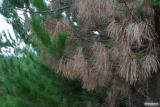Disease
The pine needle and shoot blight in Chile known as ‘Daño Foliar del Pino’ (DFP) emerged in 2004 and spread in only three years to cover an area of approximately 60 000 ha of radiata pine plantations to become the most important problem affecting plantation pine forestry in Chile. Despite intensive efforts to discover the cause of DFP, etiology was a mystery until July 2007 when a previously unknown Phytophthora species was isolated from diseased needles.
DFP was first recognized in February 2004 as unusual tree mortality in a 6-year-old P. radiata stand of about 70 ha on the Arauco coast of Chile. In the same area in October 2004, a serious needle blight disease was observed and associated with the mortality seen earlier. The area of diseased plantations peaked in 2006 and symptoms were less frequent in 2007. Disease levels remained very low through 2012.
At the height of the epidemic, the pathogen was isolated across a 600 km range in central Chile from Cardenal Caro Province in the north, south to Valdivia Province. The disease was most intense on east facing slopes near the Pacific Ocean. Only radiata pine has been affected. The long term impact of the disease will depend on the frequency at which epidemics recur and their duration, as well as the added impact resulting from secondary pathogens such as Diplodia. Despite the spectacular needle reddening and defoliation over large areas, few trees were killed in the 2004-2006 epidemic and plantations returned to near normal growth within 3 years with symptoms infrequent and usually confined to young trees adjacent to roads and close to the coast.
The symptoms of DFP on mature trees begin with a reddening of the current year’s needles in early winter. The first needles to display symptoms are those on the lower sides of the branches. Needles die and become distinctly grey and begin to fall. Initially, dead and dying needles are retained on the branches giving the trees a scorched appearance. Trees can be almost entirely defoliated. New needle growth is not affected and the trees appear to recover unless infection re-occurs in the following season. After two or three years of defoliation, trees occasionally die and this appears to be hastened due to infection by Diplodia pinea, a well-known opportunistic pathogen.
An early symptom on affected needles is a dark resinous band on the green needle, which appears transparent when viewed with backlighting. Drops of resin are often found at the base of the needles and the tissue within the papery brachyblasts is commonly collapsed and has a light grey color. Needle tissue often collapses at the base and needles hang from the branches. When the adjacent twig bark is removed, a distinct brown or reddish brown discoloration may be seen in the phloem.
Young trees are most commonly and most severely damaged, especially when growing alongside larger trees affected by DFP. One of the first and most obvious symptoms to appear on young trees is wilting of growing terminal shoots with necrotic lesions at the base. Necrosis of the cambium is more pronounced on young trees than on mature trees Lesions may coalesce to form cankers in the phloem and outer xylem. Naturally regenerated plants and newly planted seedlings are equally affected by DFP.
DFP has a distinctly seasonal pattern of occurrence. Symptoms appear in July in early winter as temperatures drop to between 6 and 12°C. This is also the start of the rainy season and there appears to be a very close association of the disease with rainfall. Southern slopes (higher humidity, most free water and low sun radiation) are most severely affected.
Pinus radiata is the only known host for P. pinifolia. Native vegetation growing adjacent to diseased radiata pine plantations is unaffected. Similarly, plantations of other exotic conifers including Pseudotsuga menziezii and Pinus pinaster are unaffected. In artificial inoculation trials, distinct lesions developed on P. radiata shoots after 15 days. Inoculated shoots wilted and the needles turned brown, in a manner very similar to symptoms on infected shoots observed in nature
| Host Latin Name | Host Common Name | Symptoms | Habitat | Region | |
|---|---|---|---|---|---|
| Pinus radiata | Radiata pine | Leaf necrosis | Plantations | Chile |




